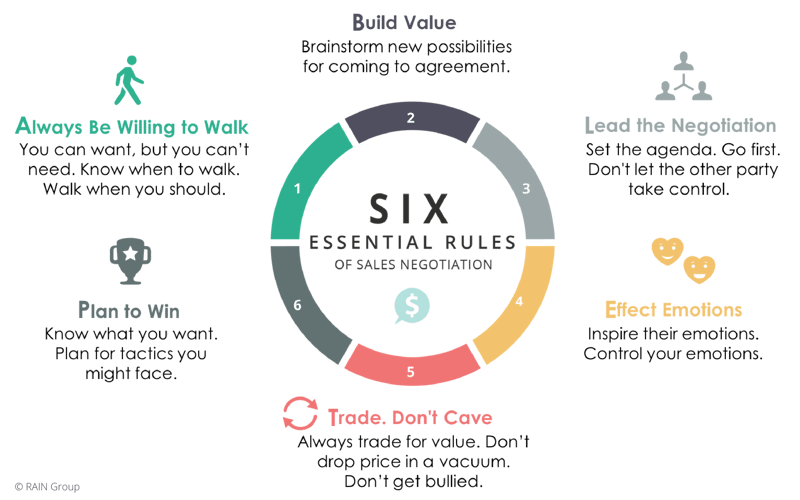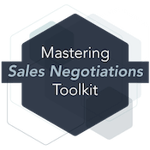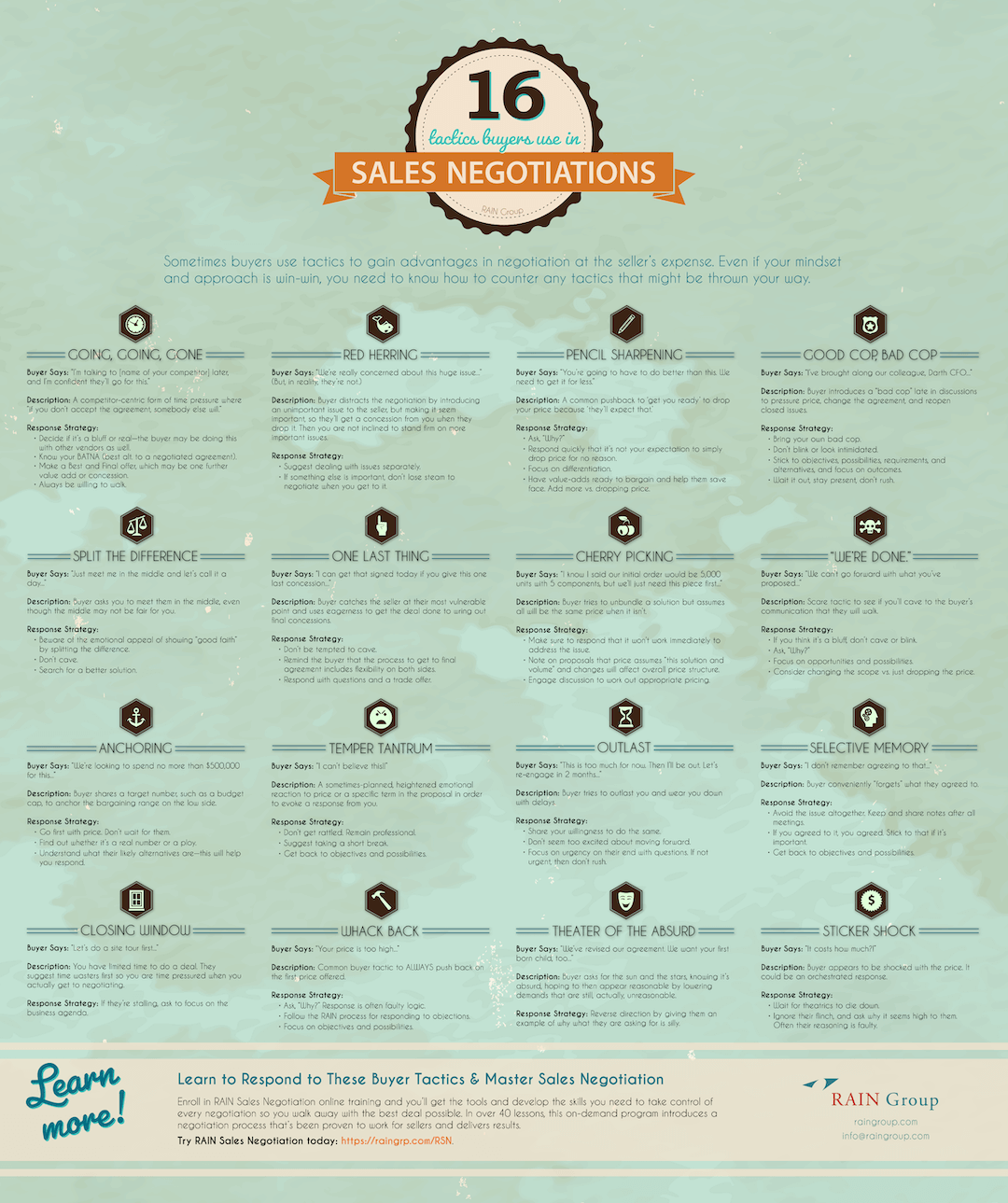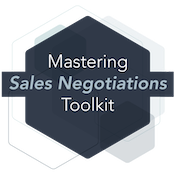Good negotiators recognize the negotiating tactics and style of the other party.
While sales negotiations are usually partner-focused (win-win), buyers often use standoffish tactics to gain an advantage at the seller's expense. Even if you have a win-win mindset and approach, you need to know how to maneuver when buyers throw you curveballs. You need the right negotiation skills to bolster your success, stay confident, and avoid caving.
This can be a challenge. Buyers say they receive discounts a whopping 88% of the time. While price concessions are a tool in your negotiation arsenal, they shouldn’t be your first option.
In this infographic, we share a quick-reference guide to 16 of the most common sales negotiation tactics buyers employ and how to respond effectively. Read on for a more thorough analysis of these techniques and how you can come to a deal that suits both you and the buyer.
Click to enlarge and view full infographic.
Common Sales Negotiation Tactics Used by Buyers
1. Going, Going, Gone
"I'm talking to [name of your competitor] later. I think they'll go for this. If they do, I'll go with them."
What it means: This is a form of time pressure where the buyer brings your competition into the ring. Essentially, they're saying, "If you don't accept the agreement, somebody else will."
How to respond: Decide if it's a bluff or the truth. The buyer may or may not be having conversations with your competitors and employing this tactic with them. Also, the other seller may accept it, but you may offer more value than them and the buyer might choose you anyway. The point is, sometimes Going, Going, Gone is more posturing than fact.
Avoid conceding too much just to make a deal by keeping your BATNA (best alternative to a negotiated agreement) in mind. If you find you're talking in circles with a prospective buyer, consider making a Best and Final Offer, which may include one further value add or a concession.
But always be willing to walk. It's better to leave a deal on the table than to agree to one that'll hurt you.
2. Red Herring
"We're really concerned about [huge issue]..." (But in reality, they're not.)
What it means: The buyer is trying to distract you from the negotiation by introducing an unimportant issue. They make it seem important and battle you on it, ultimately offering what they'll claim is a "big concession." Then they'll ask for something they actually care about that might be a big deal for you to provide.
If you object, they might say, "But look at the huge concession we just gave you! Be reasonable."
How to respond: A Red Herring is a ruse where the buyer puts up a stink (and, yes, the smell of the fish is where the term comes from) as a diversion to get you to give them something else.
To stay in control of the negotiation, deal with issues separately. Don't let them conflate one with the other.
Focus on objectives before trades by calmly responding to their objections and unpacking the value of each issue for them. Don’t agree to anything too quickly and ask the buyer to explain how each request fits into their objectives rather than dismissing them out of hand. As with many of these other tactics, this can provide an opportunity to learn more about the buyer and their needs if handled well.
3. Pencil Sharpening
"You're going to have to do better than this. We'll need to sharpen the pencils at some point."
What it means: This is a common pushback strategy to intimidate sellers into dropping the price or to corner sellers early in the process to agree to eventual price negotiations.
How to respond: First, don't just cave! Ask them "Why?" You might catch your buyer off-guard if they didn't come prepared with a valid explanation. It's important to respond quickly that your expectation isn't to simply drop price for no reason. Don't get cornered.
Furthermore, don’t ask them where they need to be. This gives buyers a window to anchor their expectations further. Find out what benchmark they’re comparing you to, if any, and ask questions to discover a solution that works for them.
Focus on your differentiation (what makes your solution the best choice) and have value-adds ready to bargain to help them save face. It's often better to add more than to drop the price. And if you do drop the price, trade, don't cave.
4. Good Cop, Bad Cop
"I've brought along my colleague, [The CFO!!!]…"
What it means: Introducing a "bad cop" late in discussions is a buyer's way of trying to lower the price, change the agreement, and/or reopen closed issues.
How to respond: To counteract this tactic, consider bringing your own bad cop! If they're calling in backup, you can too. Don't appear intimidated (frequent blinking is often a giveaway) and stick to the objectives, possibilities, requirements, and alternatives.
The bad cop will test all the boundaries, closed issues, and question everything, looking for soft spots to exploit. Be ready for it, hold your ground with confidence, and don't let them push you around. A thorough understanding of your own value and offerings helps to respond quickly and confidently—make a cheat sheet if it helps.
There's no need to rush either. Stay present and wait it out. Putting vendors through the ringer might just be a step in their common procedure. This applies to any tactics or pressure you may face in sales negotiations: once you get defensive, you’re on the backfoot and trying to respond to the buyer’s agenda rather than advancing yours.
5. Split the Difference
"Just meet me in the middle and let's call it a day."
What it means: You offer a price. The buyer suggests a lower price and says, "Okay, let’s meet in the middle."
By suggesting you meet in the middle, they make it seem like it’s win-win, even if meeting in the middle isn't fair to you.
How to respond: Make it clear that meeting in the middle isn't necessarily fair and amounts to a discount without a trade. You gave them your price. What they've done is counter with a lower price even if it's "the middle." If they want to alter things, you can talk about what might change, but meeting in the middle doesn't make sense for you.
Plus, if you meet in the middle, the buyer will expect that in the future. This isn't a good precedent to set. Remember, there are levers other than price when it comes to negotiations. If you can probe and find other ways you can drive value for the buyer, this gives you more options to trade without dropping price.
6. One Last Thing
"I can get that signed today if you give us [one last concession]…"
What it means: In this situation, the buyer is trying to catch you at your most vulnerable—right before the deal is signed. They want to take advantage of your eagerness to close the deal to squeeze out final concessions.
And it works: 85% of buyers say this is an effective negotiation tactic.
How to respond: Stay strong—don't be tempted to cave! Respond with additional questions and offer a trade if they throw "one last thing" at you. If you’ve already offered additional concessions at this point, make them increasingly smaller. Understand and communicate that any sort of concession affects the whole deal and go into closing conversations knowing what you’re prepared to offer if a buyer tries to change the deal.
Sometimes, this tactic can also be a prelude to a laundry list of other requests. Get confirmation from the buyer that there won’t be any other changes, especially if you’re agreeing to a trade.
Once an agreement has been made, get the buyer to commit to it and take the next step. End the discussion by summarizing the agreement, writing it up, and sending it to the buyer. Ask the buyer to respond with "yes" to confirm you didn't miss anything.
7. Cherry Picking
"I know I said our initial order would be 5,000 units and A-B-C services, but we'll just need 1,000 at first with no services…"
What it means: The buyer is trying to unbundle a solution and assumes everything will remain the same price, even though it won't and shouldn't.
How to respond: Address this issue immediately and communicate to the buyer it's not going to work that way. Explain that pricing on proposals assumes "this solution, volume, terms, and conditions" and changes will affect the overall price structure.
Initiate a discussion to work out appropriate pricing. If you must, tell them that you’ll need to review the new scope and make changes accordingly.
8. "We're Done."
"We can't move forward with what you're proposing…"
What it means: This is often a scare tactic. The buyer is attempting to get you to cave and give into their "threat" of walking away from the deal.
How to respond: If you have an inclination your buyer is being insincere, don't cave. Often, buyers will test a seller’s “cave tolerance” and push further if they don’t resist. Ask them their reasoning for being unhappy with the proposed solution. Focus on opportunities and possibilities you can bring to them from listening to their explanation.
Remember Rule #5 of the 6 Rules of Sales Negotiation: Trade, Don't Cave. Consider changing the scope of the proposal instead of just dropping the price. And if they’re not bluffing, you should already have an idea of what your BATNA is and what walking away might cost you.
GET THE LATEST SALES TIPS, TOOLS, AND RESOURCES
Subscribe today to get the latest on virtual selling, insight selling, strategic account management, sales conversations, and more straight to your inbox.
9. Anchoring
"We're looking to spend no more than $500,000 for this…"
What it means: Sharing a target number, such as a budget cap, is a buyer's way of anchoring the bargaining range on the low side.
How to respond: Don't wait for the buyer—go first with price. If they go first (or even second), find out whether their target number is an honest budget or a ploy to drive your price down. Understand what their possible alternatives are, and don't fall victim to meeting in the middle or dropping price because they countered.
Responding effectively to price objections starts with preparation. If you go into a negotiation with an idea of your objectives, value, leverage, and alternatives, you can dispel anchoring tactics without getting stuck negotiating around a buyer’s stated price point.
10. Temper Tantrum
"I can't believe it, that's outrageous!"
What it means: Cue the dramatics. Occasionally, you'll be faced with a buyer who expresses a (sometimes planned) heightened emotional reaction to price or a specific term in the agreement in hopes of evoking a response from you.
How to respond: Don't let them rattle you. Instead of responding with the counter-constructive behavior the buyer is trying to arouse from you, remain professional. It's clear the conversation has reached an unproductive level, so suggest taking a short break. This allows the parties involved to cool down and refocus on objectives and possibilities when the discussion resumes.
Even beyond more dramatic buyer objections, managing your own emotions during a negotiation is key to avoid a poor reaction and steer the conversation in a collaborative direction.
11. Outlast
"This is too much right now, and I'll be out of office soon for some time. Let's re-engage in two months…"
What it means: This buyer is keen on trying to outlast you and wear you down with constant delays.
How to respond: Hide your excitement about moving forward and communicate your willingness to work with them to come to an agreement more quickly, or that you'll stick around until their timing is right. Ask questions that focus on urgency on their end. If there doesn’t seem to be any urgency, don't rush it, and don’t waste too much of your time on repeat delays.
If you don't sense urgency and you want to create some, offer a trade you think might get them to move. Remember, even if you want the sale, you can’t be perceived to want it.
12. Selective Memory
"I don't remember agreeing to that…"
What it means: Your buyer has "forgotten" what they agreed to, giving them the opportunity to reframe or renegotiate the deal.
How to respond: Avoid the possibility of this issue altogether by keeping and sharing notes with your potential buyer after all meetings. If you do encounter this problem, let them know that if they agreed to it, they agreed. Stick to your convictions if they're trying to eliminate a crucial part of the deal.
Better yet, stick to the notes you share with them immediately after discussions.
13. Closing Window
"We have a few things we need to meet with you about that'll take us to 4:30 p.m. Then you'll have until 5 p.m. to give us your best and final offer..."
What it means: Buyers know if they limit your time for deal making, you might rush and make bigger concessions. This happens often in RFP processes where the buyer gives you "24 hours to respond" or something similar.
How to respond: Sometimes buyers will try to stall or waste time, so you’ll need to rush at the end. Get to key business issues first so you can maximize the time you need to think and build the right offers. Setting and following a prepared agenda for a meeting helps.
14. Whack Back
"Your price is too high…"
What it means: This is one of the most common negotiation tactics. Buyers will often push back on the first price offered.
How to respond: "Why?" is a great question to ask here. Often, the buyer's response is faulty logic. Focus on the objectives and possibilities at hand, and make sure to follow RAIN Group's process for responding to objections.
If they respond to this by comparing you to a similar service or competitor, know and communicate the ways in which you’re different. This also creates opportunities to learn what might or might not be valuable to the buyer.
Whatever the case, react calmly and evenly to their price-drop request and let some time pass. Again, they might just be testing you. Don't cave and wait it out and you'll pass the test.
15. Theater of the Absurd
"We've revised our agreement. We want [a completely unreasonable and out-of-the-question request], too."
What it means: Even though they're aware it's absurd, your buyer comes to you asking for everything under the sun anyway. They know they'll appear reasonable once they begin lowering demands even though they're still being unreasonable. Think of Theater of the Absurd as a form of extreme anchoring.
How to respond: Use reverse direction to take back control by giving them an example of why what they're asking for is silly. Don’t let these requests distract from your original terms and refer to them instead of anything that might’ve been changed.
16. Sticker Shock
"It costs HOW much?!"
What it means: Ah, Ol' Faithful. Another common example of price pushback. The buyer appears to be shocked by the cost. However, it's often an orchestrated reaction.
How to respond: Ignore their outburst and wait for the theatrics to die down. Question why it seems high to them. Often, they don't have a valid explanation for why you should discount. Get back on the same page by explaining the value of your solution. Buyers need to understand the impact your solution will have on them to justify the investment.
On Negotiation Strategy
Recognizing buyer negotiation tactics is important, but you’ll need to be proactive as well. You may have noticed that many of the responses to these tactics involve sticking to your own agenda and managing the flow of negotiation. When you can, build value and guide your buyer toward a solution that benefits everyone. If they object, dispel their objections without taking the bait.
In RAIN Group’s global research on Top Performance in Sales Negotiation, we found that top negotiators are 12.5x more likely to be very satisfied with the outcome of a negotiation and 3.1x more likely to achieve target pricing.

Based on this research, we identified 6 rules the best negotiators follow. These rules are the foundation for building and executing a successful negotiation strategy.
1. Be Willing to Walk
This is a mindset the best sales negotiators take. You can want the sale, but you can’t need the sale.
You need to 1) know when to walk away, and 2) be willing to do so. In fact, this rule is the #1 factor most separating Top Performers—those who are more likely to achieve target pricing and be satisfied with the outcome of the negotiation—from The Rest.
Walking away from a sale is hard, and it’s even harder in the tough economic conditions we face today, but you can’t be held hostage by your buyers. If it’s not in your best interest to continue a negotiation, be ready and willing to walk.
2. Focus On Building Value
Sellers who build value over the course of the sales cycle enter negotiations a step ahead of their competitors. You need to be ready to build value by brainstorming possibilities for coming to an agreement during the negotiation.
Top Performers are 2.6x (260%!) more likely to build value than The Rest. They also outperform The Rest nearly twice as often when it comes to articulating their value and differentiation.
Want to be like the best? Focus on building value before and during the negotiation.
3. Lead the Negotiation
Set the agenda, kick off the meeting right, go first, and manage the flow of the negotiation. If you don’t, the buyer will, and it gives them the upper hand. Even beyond this, some buyers might not be as confident going into sales negotiations. This is especially true when negotiating with procurement.
Top Performers are 1.9x more likely to take the lead. Notably, sellers who make the opening offer are more likely to be very satisfied with the outcome of the negotiation, and Top Performers are 2.4x more likely to strongly agree they do it compared to The Rest.
Take the lead with your negotiations and guide your buyers down the right path.
4. Effect Emotions
Negotiations are emotional affairs. The best negotiators draw out and elicit certain emotions from buyers and themselves. They need to inspire others while controlling their own emotions.
For example, most sellers experience buyers reacting emotionally to price. The difference is that Top Performers are 2.2x more likely to be prepared to manage these emotions and respond effectively.
5. Trade, Don't Cave
The majority of sellers cave on price. When the buyer says, "Your price is too high, what can you do?", don't give in and simply lower the price.
Always trade for value. Top Performers are 2.6x more likely than The Rest to be prepared to trade. It's an important negotiating philosophy to adopt.
6. Plan to Win
Sellers who are prepared for negotiations perform better. Know what you want, know what's important to you, and plan for buyer tactics you might face.
This includes preparing for how you might respond to buyer requests, planning what you're willing to trade, and brainstorming ideas for adding value to the agreement ahead of time.
Top Performers are 1.7x more likely than The Rest to be prepared to negotiate.
Learn more about the 6 Essential Rules of Sales Negotiation here. >>
Stay in Control of Sales Negotiations
Like any other sales skill, negotiation takes work and experience to master. However, with an understanding of negotiation tactics and by following the 6 Essential Rules of Sales Negotiation, you can avoid dropping prices, build win-win solutions, and stick to your objectives.








